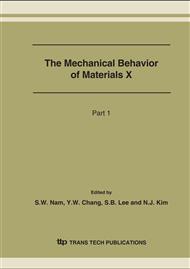p.1493
p.1497
p.1503
p.1507
p.1511
p.1515
p.1521
p.1525
p.1529
Fracture Toughness of Epoxy Resins Containing Blends of Monomers with Different Molecular Weights
Abstract:
The effect of adding a high molecular weight epoxy monomer (epikote 1001) to a low molecular weight one (epikote 828) on fracture toughness properties was investigated according to the crosslinking degree and density heterogeneity. To characterize the crosslinking degree and density heterogeneity, the glass transition temperature, Tg, and fragility, m, were deduced from thermo-viscoelastic properties. The characterization of Tg and m revealed that blends can be divided into two groups: one group with (φ < 10 wt%) and another one with (φ > 10 wt%), where φ is the weight ratio of epikote 1001 to epikote 828. The first group had the same average crosslinking degree (the same Tg) but different density heterogeneities (m decreased). The other group had a lower crosslinking degree (Tg decreased) and even more density heterogeneity (m decreased). The fracture toughness results showed that KIC of blends of the first group was approximately constant because the increase in density heterogeneity was still too weak (ineffective m), whereas KIC of blends of the second group was higher due to the simultaneous decrease in average crosslinking degree and increase in density heterogeneity. Therefore, the lower crosslinking degree (lower Tg) is and the more heterogeneous the blend (lower m) is due to the addition of high molecular weight monomer, the higher KIC becomes.
Info:
Periodical:
Pages:
1511-1514
Citation:
Online since:
August 2007
Authors:
Price:
Сopyright:
© 2007 Trans Tech Publications Ltd. All Rights Reserved
Share:
Citation:


